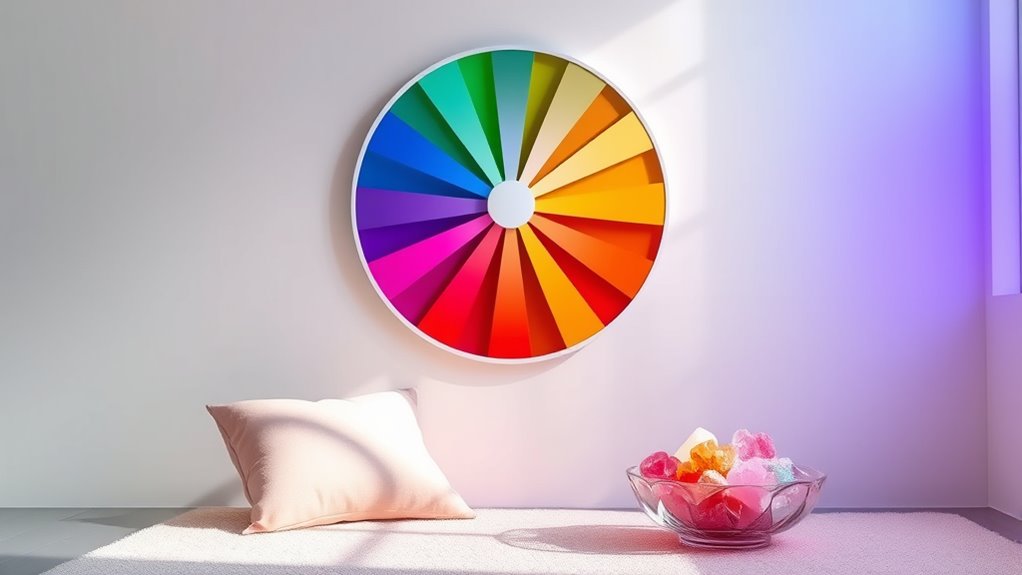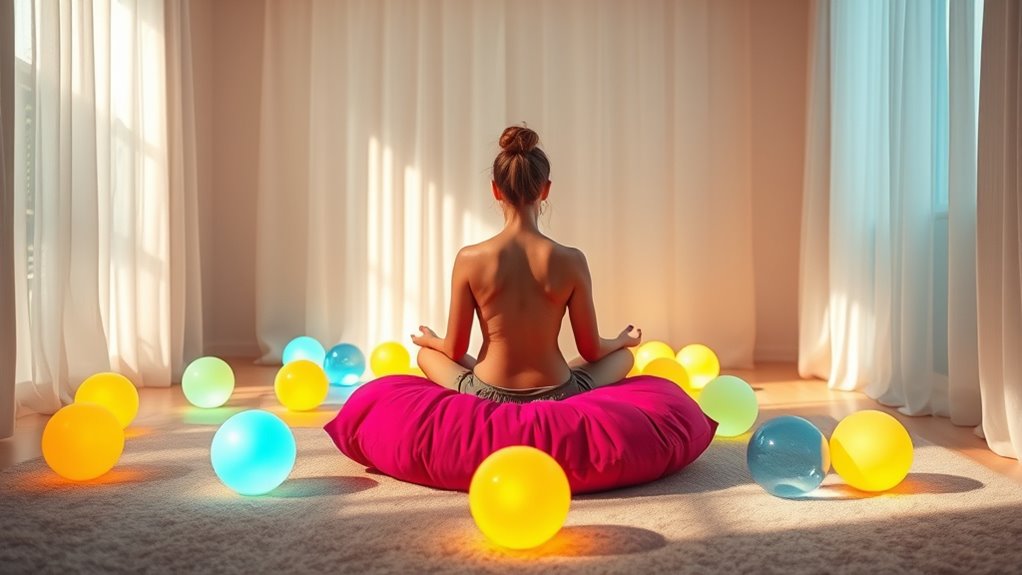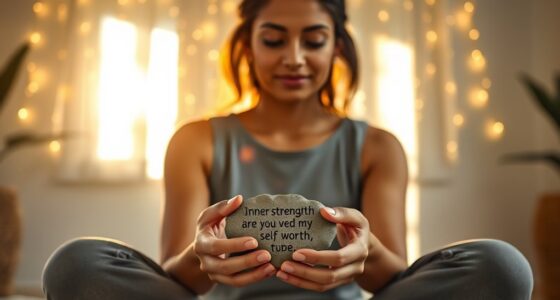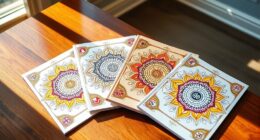Color therapy uses specific hues to help you balance your mood and support your mental health. By intentionally choosing calming colors like blue or green, you can reduce anxiety and promote relaxation. Bright shades such as yellow or orange can boost your energy and motivation. Applying these colors in your environment or daily routines can make a real difference. Keep exploring to discover how blending color psychology with your lifestyle can empower your emotional well-being.
Key Takeaways
- Different hues influence mood, with calming colors like blue reducing anxiety and energetic shades like yellow boosting alertness.
- Selecting specific colors for environments or clothing can help stabilize emotions and manage mood swings effectively.
- Visualization of soothing colors supports relaxation, lowers stress, and promotes emotional balance during challenging times.
- Incorporating color symbolism, such as pink for tenderness or red for energy, aids in addressing emotional needs.
- Combining color therapy with environmental changes and routines enhances overall emotional well-being and mood regulation.

Color therapy is a holistic approach that uses different colors to influence your mood, emotions, and overall well-being. When you understand color symbolism, you gain insight into how specific hues can evoke particular feelings or states of mind. For example, red often symbolizes energy, passion, or urgency, while blue is associated with calmness, trust, and serenity. This understanding stems from the principles of color psychology, which studies how colors impact human behavior and emotional responses. By consciously choosing certain colors in your environment or through visualizations, you can harness their power to help balance your mood and reduce mood swings.
Color symbolism helps balance your mood by evoking feelings of calm or energy through conscious color choices.
When you incorporate color symbolism into your daily life, you can create spaces or routines that promote emotional stability. For instance, wearing soft pastel shades like pink or lavender might foster relaxation and tenderness, while brighter shades such as yellow or orange can boost your energy levels and combat feelings of lethargy or sadness. Recognizing the psychological effects behind these colors allows you to tailor your surroundings to support your mental health. You might paint a wall in your living room a soothing blue or keep a calming green plant nearby, reinforcing the psychological benefits associated with those colors. This intentional use of color can serve as a subtle yet effective tool for managing fluctuating moods.
Color psychology also plays a crucial role when you use visual cues to influence your emotional state. For example, during stressful periods, you might focus on visualizing or wearing calming shades like blue, which research suggests can lower blood pressure and reduce anxiety. Conversely, if you need a boost of motivation, incorporating energetic colors like red or yellow into your environment can inspire alertness and enthusiasm. The key is understanding the emotional associations tied to different colors and applying them thoughtfully. Over time, this awareness helps you develop a personalized palette that supports your mental health and helps you navigate mood swings more effectively.
In essence, by understanding the principles of color symbolism and color psychology, you empower yourself to influence your emotional landscape deliberately. You can create environments and routines that foster positivity, serenity, or energy, depending on your needs. Whether through choosing specific colors for your clothing, decor, or mindfulness practices, you’re actively engaging with the emotional power of hues. This awareness transforms color therapy from mere aesthetics into a practical, accessible tool for emotional regulation, helping you feel more balanced and in control of your mood swings. Additionally, selecting vacuums with HEPA filters can contribute to improved indoor air quality, further supporting emotional well-being by reducing allergens and irritants.
Frequently Asked Questions
Can Color Therapy Replace Traditional Mental Health Treatments?
You might wonder if color therapy can replace traditional mental health treatments. While it leverages color symbolism and taps into the emotional impact of hues to promote healing, it shouldn’t substitute proven therapies like counseling or medication. Instead, consider it a holistic approach that can enhance your overall well-being. Always consult mental health professionals to create a thorough treatment plan tailored to your needs.
Are There Any Risks Associated With Color Therapy?
You might wonder if there are risks with color therapy. While generally safe, you should consider lighting safety, ensuring the lights used aren’t too intense or cause eye strain. Poor color selection can also trigger discomfort or adverse reactions, especially if you’re sensitive to certain hues. Always choose appropriate lighting and colors tailored to your needs, and consult a professional if you have concerns about how color therapy might affect you.
How Long Does It Take to See Results From Color Therapy?
When wondering about the timing expectations for seeing results from color therapy, it varies based on individual factors and the issues you’re addressing. Typically, you might notice a visual impact or mood shift within a few sessions, but more significant changes could take weeks. Patience is key, and consistent exposure helps your mind adapt, allowing positive effects to gradually manifest over time.
Is Color Therapy Suitable for Children and Seniors?
You might wonder if color therapy suits children and seniors. It’s generally safe, especially with child-friendly practices that use gentle, engaging techniques. For seniors, senior-specific approaches focus on comfort and accessibility. While results vary, many find it beneficial for mood and relaxation. Always consult a professional to tailor the therapy to individual needs, ensuring it’s appropriate and effective for both age groups.
Do Individual Color Preferences Affect Therapy Effectiveness?
Your personal color choices can influence how effective color therapy is for you. While some people respond better to certain hues, cultural color symbolism also plays a role in shaping your preferences. If you’re drawn to specific colors, it may enhance your comfort and openness during therapy. Understanding your individual preferences and cultural associations helps tailor the approach, making it more meaningful and potentially more effective in healing mood swings.
Conclusion
By incorporating color therapy into your routine, you can effectively influence your mood and promote emotional balance. Studies show that over 65% of people who use color therapy report improved mental clarity and reduced anxiety. So, next time you’re feeling overwhelmed, consider surrounding yourself with calming hues like blue or energizing shades like yellow. Embracing color therapy offers a simple, natural way to support your emotional well-being and regain control of your mood.










